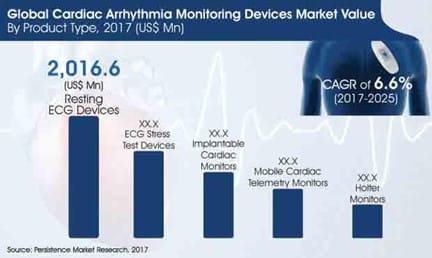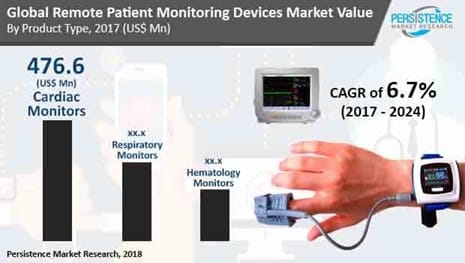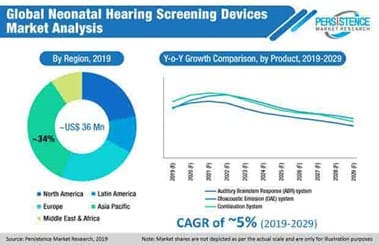
Medical devices range from surgical equipment to wheelchairs. The surge in demand on their part could be credited to the ever-increasing patient pool contracting various ailments, followed by road mishaps increasing at an alarming rate. Also, cardiovascular diseases and aging population are adding to the need for medical devices.
The ECG devices hold the largest market share amongst the medical devices, more so due to prevalence of heart-oriented ailments and the stress that precedes them. By type, they are resting ECG devices, stress ECG devices, Holter monitors, implantable loop recorders, event monitors, MCT devices, and smart ECG monitors. Lead-wise, they say 6-lead, 3-lead, 5-lead, and 12-lead. With home care settings picking up, GE Healthcare’s collaboration with “Preventice Solutions” has paved the way for the former’s ECG services to monitor ambulatory ECG patients.

Cardiovascular ailments are also asking for cardiac arrhythmia monitoring devices. By product, they are event monitor, ICM (Insertable Cardiac Monitor), mobile cardiac telemetry devices, Holter Monitor, and loop monitor. Application-wise, they are coronary artery disease, arrhythmia, and hypertension.
It’s mandatory to unique device identification numbers in the US since September 2007. The basic advantage is that counterfeit products could be easily identified. Also, the medical fraternity would be able to differentiate amongst the devices looking similar but having different functionalities. This initiative is, however, facing challenges in the form of non-uniformity of regulations all across.
With relentless efforts being made to make healthcare an easy-going process, homecare medical equipment have sprung up in the last few years. The trend is expected to continue even going forward with the ongoing pandemic asking for isolation. Functionality-wise, they comprise home dialysis equipment, home IV equipment, home respiratory therapy equipment, oxygen concentrators, home liquid oxygen containers, oxygen cannula, ventilators, nebulizers, humidifiers, home negative pressure wound therapy devices, home automated external defibrillators, home muscle & nerve stimulators, home braces & related products, and home physical therapy equipment.

Extending further, remote patient monitoring system is doing the rounds. It works wonders with respect to chronic disease management in terms of early warning signals and the progress tracker. Also, emergency visits to hospitals could be easily avoided. Amongst the vital sign monitors, remote patient monitoring devices include pulse oximeters, blood pressure monitors, temperature monitor, ECG, EEG, and respiratory rate monitor. The specialized monitors include blood glucose monitors, anesthesia monitors, cardiac rhythm monitor, fetal heart monitors, prothrombin monitors, MPM (Multi Parameter Monitors), and respiratory monitor.
Diagnostic imaging devices are in demand due to various advancements in radiology. They include X-Ray machines, CT scans, tomography machines, Ultrasound system, and others. Out of these, ultrasound system holds the largest market share.

On the other hand, neonatal hearing screening devices are witnessing a skyrocketing demand with increase in birth rate in the developing countries like Uganda, Mali, certain countries of Africa, and the Republic of Niger coupled with them being at the risk of various neonatal problems. The other countries where birth rate is moderate also ask for neonatal hearing screening services. They are Saudi Arabia, South Africa, Mexico, and India.
Ultrasonic skin care devices are picking up pace with acne, tanning, and various other diseases taking the centre-stage with pollution adversely affecting the skin. As of now, non-invasive ultrasonic skin care devices are preferred due to them being safe. The application areas include skin rejuvenation, skin tightening, and others related to body contouring.
Persistence Market Research (PMR) has, through its market study on “Medical Devices”, profiled players like:
- Accuray Inc.
- Johnson & Johnson
- GE Healthcare
- Siemens
- Fresenius
- Bio-Rad Laboratories, Inc.
- Boston Scientific Corp.
- Abiomed Inc.
- Stryker
- Baxter International Inc.
- Angiodynamics Inc.
- Biotelemetry, Inc.
Coming to distribution geography-wise, PMR states that North America and Europe hold the largest share of medical devices market. This could be reasoned with these two regions being well-versed with healthcare solutions. Also, they are not behind with regards to technological advancements. Majority of manufacturers of medical devices have their headquarters in these two geographies. PMR has also stated that the Asia-Pacific is poised to be the focal point herein in future. This could be attributed to the fact that this region is witnessing an increasing number of people with AF (atrial fibrillation). As per data released by the Japanese Heart Rhythm Society (2017), close to 72 Mn people from the Asian continent will be affected by AF by the year 2050, out of which about 2.9 Mn may witness AF-related strokes.


